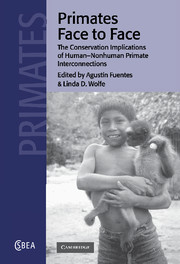Part 1 - Science and nonhuman primates
Published online by Cambridge University Press: 20 October 2009
Summary
Because nonhuman primates are our closest living phylogenetic relatives, nonhuman primates have been put to use in many different aspects of scientific research, such as biomedical research, and as models for human evolution. In order for scientists to conduct biomedical research on nonhuman primates and extrapolate that research to humans, certain assumptions have to be made concerning the nature and evolution of prosimians, monkeys, and apes. For example, it is often assumed that the stress of caging a nonhuman primate has no effect on its physiology. Fouts, Fouts, and Waters argue in Chapter 3 that the stress of being caged coupled with isolation can affect an animal's physiology, thereby calling into question any data gathered on a stressed animal.
When using nonhuman primates for models of human evolution we run the risk of falling into the assumption that nonhuman primates have not substantially changed since our last common ancestor. However, most anthropologists would agree that adaptations have changed over the millennia and urge caution when extrapolating from the behaviors of extant nonhuman primates to past or present human behaviors.
The three chapters in this part of the book address the issue of how nonhuman primates are viewed by social scientists and biomedical researchers.
- Type
- Chapter
- Information
- Primates Face to FaceThe Conservation Implications of Human-nonhuman Primate Interconnections, pp. 5 - 6Publisher: Cambridge University PressPrint publication year: 2002



